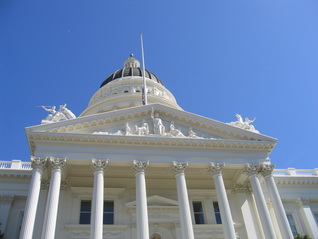As has been widely reported, a particularly dishonest campaign by the Western States Petroleum Association, combined with the tendency of a large bloc of Assembly Democrats (and all of the Republicans save one) to represent special interests rather than their constituents – resulted in the petroleum reduction section of SB 350 (De León) being dropped from the bill so that the remainder of the bill could pass the Assembly floor.
The reporting has mostly missed some key points:
1. To anyone who understands the Legislature, this should not have been a surprise; we always knew that the current make-up of the Assembly was not congenial to bills that challenge the oil industry or other big business lobbies. Recent elections have produced a large crop of Assembly Democrats who call themselves “moderates,” which is misleading. As the Sacramento Bee’s Dan Morain points out, what really defines these legislators is “a willingness to accept campaign contributions from oil, tobacco, or anyone else, and their malleability when donors come calling.” The oil industry spent $17.2 million on California state campaigns last year, and is now reaping a return on its investment. Everything the oil industry said in its anti-SB 350 ads was a lie, and polling by the non-partisan Public Policy Institute of California showed overwhelming support for all of SB 350’s central provisions, but that didn’t stop legislators from parroting the industry’s talking points.
 2. Despite the loss of the petroleum section, SB 350 is a huge accomplishment. What’s left in SB 350, when signed into law by the Governor, amounts to a dramatic plan to reshape the energy economy of California. The Brown-De León pillars of 50% renewable electricity and a doubling in efficiency of electricity and natural gas use, both by 2030, would each, on their own, constitute major accomplishments. To pass two of them in one year is unprecedented. In addition, a section of SB 350 that has gone almost completely overlooked establishes that a “principal goal” of electric utility “resource planning and investment” is “to improve the environment and to encourage the diversity of energy resources through improvements in energy efficiency, development of renewable energy resources, and widespread transportation electrification.” So a major mechanism for petroleum reduction remains intact – fueling our cars and trucks with electricity, which will be increasingly clean as the 50% renewable requirement takes hold. For more on that provision, see this excellent blog by NRDC’s Max Baumhefner.
2. Despite the loss of the petroleum section, SB 350 is a huge accomplishment. What’s left in SB 350, when signed into law by the Governor, amounts to a dramatic plan to reshape the energy economy of California. The Brown-De León pillars of 50% renewable electricity and a doubling in efficiency of electricity and natural gas use, both by 2030, would each, on their own, constitute major accomplishments. To pass two of them in one year is unprecedented. In addition, a section of SB 350 that has gone almost completely overlooked establishes that a “principal goal” of electric utility “resource planning and investment” is “to improve the environment and to encourage the diversity of energy resources through improvements in energy efficiency, development of renewable energy resources, and widespread transportation electrification.” So a major mechanism for petroleum reduction remains intact – fueling our cars and trucks with electricity, which will be increasingly clean as the 50% renewable requirement takes hold. For more on that provision, see this excellent blog by NRDC’s Max Baumhefner.
3. As Governor Brown said in his bravura press conference remarks, the executive branch already has the authority to take virtually all of the steps needed to reduce oil use in vehicles, from the Zero-Emission Vehicle mandate to the Sustainable Freight Strategy, Low-Carbon Fuel Standard and SB 375 Sustainable Communities planning. He and his staff have made it clear that they plan to go forward with their petroleum reduction agenda, so the oilies may find that their victory leaves a Pyrrhic after-taste.
SB 32 (Pavley), which would have put the Governor’s greenhouse gas reduction targets of 40% by 2030 and 80% by 2050 into law, failed 30-35 on the Assembly floor, thanks to those same oil-friendly legislators, and is now a 2-year bill. But the Air Resources Board is proceeding with an updated Scoping Plan using those targets and its existing authority under AB 32, the Global Warming Solutions Act of 2006 (Nuñez-Pavley).
Finally, from the wreckage of SB 32 emerged a new bill, AB 1288 (Atkins), which will add two seats to the ARB reserved for members who “work directly with communities in the state that are most significantly burdened by, and vulnerable to, high levels of pollution, including, but not limited to, communities with diverse racial and ethnic populations and communities with low-income populations.” Coalition for Clean Air strongly supports the bill, and we urge the Governor to sign it into law.
[share title=”Share This Post”]







